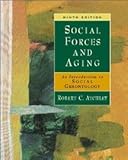Social forces and aging : an introduction to social gerontology / Robert C. Atchley.
Publication details: Belmont, Ca. : Wadsworth, c2000.Edition: 9th editionDescription: xvi, 574 p. : ill. ; 25 cmISBN:- 0534533434
- 9780534533434
- WT 100 A863s 2000
| Item type | Current library | Call number | Copy number | Status | Date due | Barcode |
|---|---|---|---|---|---|---|
 Book Closed Access
Book Closed Access
|
Health Sciences Library | WT 100 A863s 2000 (Browse shelf(Opens below)) | 1 | Available | MBAL22066216 |
Includes bibliographical references and index.
Contents
PART ONE: SETTING THE STAGE.
1. THE SCOPE OF SOCIAL GERONTOLOGY.
What is Gerontology?
What is Human Aging?
Defining the Aging and the Older Populations.
Social Gerontology is a Unique Field of Study.
Social Policy Issues. Professional Practice.
Careers in the Field of Aging.
Summary.
2. THE DEMOGRAPHY OF AGING.
Measuring Age Structure.
Growth of the older Population.
Composition of the Older Population.
Geographic Distribution of the Older Population.
Living Arrangements. Population Processes and the Older Population. Summary.
3. THE HISTORY OF AGING IN AMERICA.
Modernization Theory.
Aging in Colonial America.
From the Revolution to the Civil War, The Beginning of Industrialization.
Civil War to 1900. 1900 to 1929.
The Great Depression. 1942 to 1965.
1965 to 1980.
The 1980''s.
Modernization.
Theory Revisited. Summary.
PART TWO: BASIC ASPECTS OF INDIVIDUAL AGING.
4. PHYSICAL AGING.
Why We Grow Older.
Physical Consequences of Aging.
Summary.
5. PSYCHOLOGICAL ASPECTS OF AGING.
Aging and Specific Psychological Functions.
Adult Development: Personality, Self, and Life Structure.
Mental Disorders.
Summary.
6. SOCIAL ASPECTS OF INDIVIDUAL AGING.
Defining Social Aging, Social Roles.
The Cultural Life Course.
Socialization and Acculturation.
Role Anticipation and Adaptation.
Social Factors in Individual Development.
Aging and Changes in Social Context.
Lifestyles. Summary.
7. PERSONAL ADAPTATION TO AGING.
What is Adaptation?
General Ways to Adapt.
Specific Adaptations.
Escape Rather Than Adaptation.
Effective Adaptation.
Summary.
PART THREE: AGING IN DOMAINS OF EVERYDAY LIFE.
8. FAMILY, FRIENDS, AND SOCIAL SUPPORT.
Types of Bonding.
Family.
Friends.
Social Support.
Summary.
9. EMPLOYMENT AND RETIREMENT.
Midlife Career Changes.
Employment Problems of Older Workers.
Bridges to Retirement.
Retirement.
The Retirement Process.
Effects of Retirements on Individuals.
Summary.
10. ACTIVITIES AND LIFESTYLES.
Concepts About Activities.
Activities in Middle Adulthood.
Aging and Changes in Activities.
Spheres of Activity.
What Activities are Desirable for Older People?
Summary.
11. RELIGION AND SPIRITUALITY.
Concepts and Language.
Organized Religion.
Attending Religious Services.
Informal Religious Behavior.
Subjective Elements of Religion and Spirituality.
Conceptions for Spiritual Development.
Effects of Religion and Spirituality.
Research Issues.
Summary.
12. DYING, DEATH, BEREAVEMENT, AND WIDOWHOOD.
Defining Death.
Dealing with Dying.
Bereavement.
Death of a Spouse.
Summary.
PART FOUR: AGING AFFECTS NEEDS AND RESOURCES.
13. INCOME AND HOUSING. INCOME.
Housing.
Summary.
14. HEALTH AND LONG-TERM CARE.
Health Care, Health Care Needs.
Long-Term Care, Regulation of Health and Long-Term Care.
Summary.
15. COMMUNITY SOCIAL SERVICES.
Community Facilities That Serve Older People.
Services.
The Organization and Financing of Social Services.
Summary.
PART FIVE: AGING AND SOCIETY.
16. AGING IN CONTEMPORARY AMERICA SOCIETY AND CULTURE.
The Nature of Society and Culture.
Ideas About Aging.
Language.
Age Prejudice and Discrimination.
Societal Disengagement.
Age Stratification.
Ethics. Law, and Aging.
Summary.
17. SOCIAL INEQUALITY.
Social Class.
Dimensions of Disadvantage.
Race.
Ethnicity.
Gender.
Multiple Jeopardy.
Summary.
18. THE ECONOMY.
Economic Ideology.
Economic Structure.
The Economic Functions of Retirement.
The Economics of Retirement Income.
Retirement Income in the Future.
Private Enterprise and the Aging Problem.
Aging People as Consumers.
Economic Exploitation of Elders.
Summary.
19. POLITICS AND GOVERNMENT.
Overview.
Political Activity.
Political Influence.
Government Response to Issues Concerning Aging.
Making Policy. Summary.
20. EPILOGUE: AGING AND THE FUTURE.
Directions of Social Change.
Demographic clues to the future.
The Future of Psychological Aging.
The Future of Social Aging.
Society's Futures Response.
The Future of Social Gerontology.


There are no comments on this title.